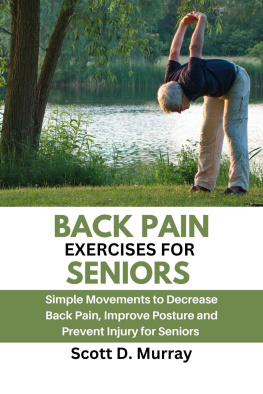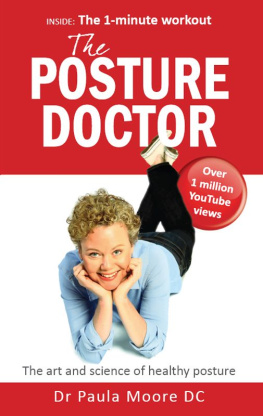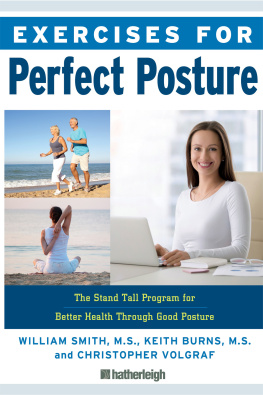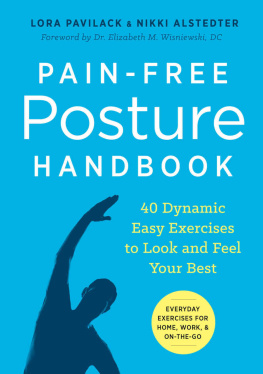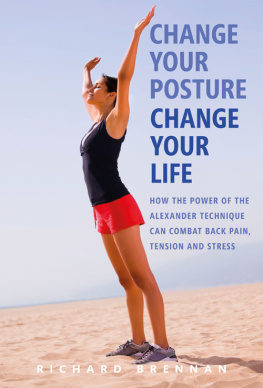Defying the PAINS
of GRAVITY
USING PROPER POSTURE TECHNIQUE
Jeff LaBianco, DPT, CSCS
iUniverse, Inc.
Bloomington
Defying the Pains of Gravity
Using Proper Posture Technique
Copyright 2012 by Jeff LaBianco, DPT, CSCS.
All rights reserved. No part of this book may be used or reproduced by any means, graphic, electronic, or mechanical, including photocopying, recording, taping or by any information storage retrieval system without the written permission of the publisher except in the case of brief quotations embodied in critical articles and reviews.
The information, ideas, and suggestions in this book are not intended as a substitute for professional medical advice. Before following any suggestions contained in this book, you should consult your personal physician. Neither the author nor the publisher shall be liable or responsible for any loss or damage allegedly arising as a consequence of your use or application of any information or suggestions in this book.
iUniverse books may be ordered through booksellers or by contacting:
iUniverse
1663 Liberty Drive
Bloomington, IN 47403
www.iuniverse.com
1-800-Authors (1-800-288-4677)
Because of the dynamic nature of the Internet, any web addresses or links contained in this book may have changed since publication and may no longer be valid. The views expressed in this work are solely those of the author and do not necessarily reflect the views of the publisher, and the publisher hereby disclaims any responsibility for them.
Any people depicted in stock imagery provided by Thinkstock are models, and such images are being used for illustrative purposes only.
Certain stock imagery Thinkstock.
ISBN: 978-1-4759-5713-6 (sc)
ISBN: 978-1-4759-5715-0 (hc)
ISBN: 978-1-4759-5714-3 (ebk)
Library of Congress Control Number: 2012919643
iUniverse rev. date: 10/26/2012
Contents
I wrote this book in order to provide the general public with a simple-to-understand guide on how to prevent and decrease joint pain through proper posture. I began writing this book about one year after practicing as a physical therapist. Many of my patients appreciate and understand the importance of proper posture as I explain it to them during their therapy sessions. They have asked me where they can find resources that illustrate these same concepts in an easy-to-understand manner. As I thought about it I could not give them any specific references. The books that I could cite were either too in-depth or too difficult to understand without formal education. So I decided that I would give them my own reference. After working with patients ranging from juveniles to geriatrics and diagnoses ranging from neck strains to strokes, I have detailed the essence of proper posture in this short, clear guide.
This book is divided into two sections. The first section provides the reader with an overview of how the body works as a whole, what causes postural deficits, and how one can effectively correct them. The second section provides specific workout protocols that combine key strength and stretching exercises to help maintain proper posture and flexibility. Though it may be tempting to jump to the exercise protocol section, I invite you to read this book from start to finish so that you can fully appreciate the body and its functioning.
I would like to give special thanks to all of my former patients. Without your dedication to improve and your thirst for knowledge about this subject matter, this book would not have been possible.
I would also like to thank my good friend Jasmine Vargas for modeling my book and my father Steve LaBianco for photographing my book. Thanks also go out to my former coworker and physical therapist Andrew Sullivan, my brother and pedorthist Scott LaBianco for critiquing my book, and to my current colleagues for their support.
Lastly, I would like to thank my family. Without your love and support I would not be in the position to write this book.
Introduction
Have you ever noticed how many different positions we place ourselves in throughout the day? Whether youre sitting, standing, walking, or running, bending over to pick up an object or standing with arms outstretched while replacing a lightbulb, your body is turned, tied, and twisted in numerous positions. Luckily, each of us is built to withstand most of these daily stressors, but sometimes our bodies are pushed over the limit, leading to injury. There are three main causes of injury:
1. Repetitive movements
2. Traumatic movements
3. Prolonged insufficient positioning
Because we are subjected to daily tasks that drive us to perform movements over and over again, use improper body mechanics that cause pains and strains, and place ourselves in unnatural, damaging positions, we must be aware of these factors and act accordingly. By understanding how an injury is caused, and by simply thinking about the positions we place ourselves in, we have the means to prevent discomfort by changing our daily habits.
Chapter One
Posture. The dreaded P word. Brings back memories doesnt it? Put your shoulders back, your mother would insist as you slumped in your chair as a child. Stand up straight, your teacher would whisper while you pledged allegiance to the flag. Well, believe it or not, they had a point. Posture is important! Maintaining proper posture helps prevent aches, pains, arthritis, degenerative changes, and even neurological dysfunctions.
The reason why many individuals have so much difficulty keeping themselves in the correct position is related to a simple rule of physics. There is a force constantly pulling down on usa force commonly known as gravity. So why wouldnt we slump down? Its easier than sitting up straight. Were designed to adapt to our surroundings, and because of this we take the path of least resistance, unconsciously allowing ourselves to slouch and fall into typical poor posture. The problem is that, when poor posture is sustained day in and day out, some of our tissue structuresincluding ligaments, tendons, and musclesbecome weak and lengthened while others become weak and shortened. This unbalanced push-pull effect will eventually cause degenerative changes within our joints because our tissue structures will become unable to absorb the same amount of force they normally do when they are at their proper length.
Cartilage, ligaments, tendons, and muscles naturally act as shock absorbers in our bodies. They help prevent damage to the bone structure of our joints as we locomote.
Our bodies contain two main types of cartilage. Hyaline cartilage surrounds every joint in our limbs. It is present at each end of our bones so that when bones connect to form a joint, they are able to glide over each other just as easily as a piece of ice sliding over a frozen pond. Thick, dense fibrocartilage is located between the vertebrae of the spine. This type of cartilage is responsible for preventing impact and allowing mobility throughout the spine.
Ligaments are short bands of tough, flexible, fibrous connective tissue that connect bone to bone. I like to refer to them as joint connectors. They aid in the stabilization and shock absorption of the joint. Tendons, which connect muscles to bones, are flexible but inelastic cords made up of strong fibrous collagen tissue. Each muscle contains one tendon on each end, and each tendon connects the muscle to small attachments on a bone. Most muscles in the body cross at least one joint, allowing us to move our trunk and limbs once the muscle is contracted.
These tissue structures are located around each joint and have a similar job as the shocks on a bike.

Next page

